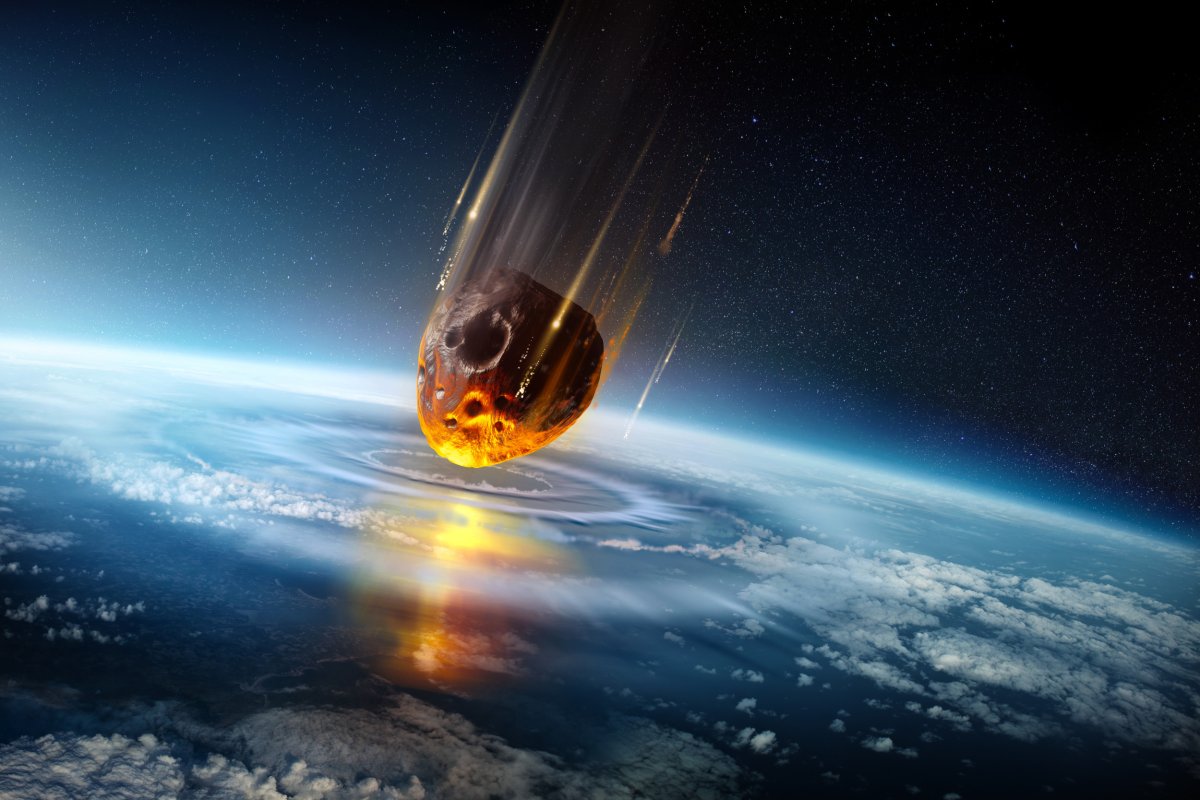Asteroid impacts at key moments in the Earth's past could have set off global freezes that covered the entire planet in ice for thousands or even millions of years.
This is the conclusion of a study led by researchers at Yale University, who modeled the climatic consequences of a large asteroid strike at four points in our planet's past in a study published in the journal Science Advances.
An asteroid impact would eject a considerable amount of material into the Earth's atmosphere, blocking out the sun's rays and leading to cooling as a result. The team found that, in an already suitably cold climate, this effect could tip the Earth system into runaway cooling, leading to what scientists have dubbed a "Snowball Earth."
However, experts not involved in the study told Newsweek that, at present, there is no evidence to suggest that any asteroids did strike Earth around the times in the past when such global glaciations are known to have occurred.
Thanks to their modeling, climate scientists have known since the late sixties that if the Earth were to get sufficiently cold, it would create a positive feedback loop leading to runaway cooling until the entire planet was covered in ice.
This "Snowball Earth" outcome begins with the ice sheets spreading out further from the poles. As ice is more reflective than water or land, this would increase the amount of sunlight cast back into space, leading to further cooling.
This, in turn, leads to the formation of more ice, colder temperatures, and so forth—a cascade that would only stop when the entire planet was completely covered in ice and had entered into a new equilibrium state.
Based on the projected distributions of glacial sediments, alongside other evidence, scientists believe that Earth has entered a "snowball" state at least twice in the past, at points between 720 and 635 million years ago.
Exactly what set off these episodes of runaway cooling, however, has been a subject of considerable debate.
The conventional hypothesis, however, has been that the level of Earth-warming greenhouse gasses somehow decreased to such a point that the "snowballing" process began.

"We decided to explore an alternative possibility," said paper author and climate dynamicist Minmin Fu of Yale University in a statement.
"What if an extraterrestrial impact caused this climate change transition very abruptly?"
In their study, Fu and his colleagues made use of the same kind of model that is employed to predict future climate scenarios. Such models can simulate both atmospheric and ocean circulation, as well as the formation of sea ice, under different scenarios.
The team explored the aftermath of a hypothetical large asteroid collision—equivalent in size to the dinosaur-killing Chicxulub impactor—during four quite different periods in the Earth's past.
These included the Neoproterozoic Era (1 billion–542 million years ago); the Cretaceous Period (145–66 million years), the Last Glacial Maximum (21,000 years ago, when ice sheets covered much of Northern America, Northern Europe and Asia), and the pre-industrial period (more than 150 years ago).
The researchers determined that in the two warmer periods they examined—the pre-industrial and Cretaceous Periods—it is unlikely that an asteroid impact would have been able to trigger a "Snowball Earth" condition.
The picture appeared very different, however, when they considered an impact scenario in the Neoproterozoic, or at the Last Glacial Maximum.
During these periods in Earth's history, the team explained, global temperatures may have been cold enough to warrant calling them an ice age.
The effects of an asteroid impact during these chilly periods, they added, may have pushed the Earth over a climate tipping point and into a global glaciation.

The modeling indicated that an asteroid-triggered shift to a frozen Earth would have been relatively rapid.
"What surprised me most in our results is that, given sufficiently cold initial climate conditions, a 'Snowball' state after an asteroid impact can develop over the global ocean in a matter of just one decade," said paper co-author and Yale climate scientist professor Alexey Fedorov.
"By then, the thickness of sea ice at the Equator would reach about 10 meters [33 feet]," he added.
"This should be compared to a typical sea ice thickness of one-to-three meters [around 3–10 feet] in the modern Arctic."
Professor Ian Fairchild, a geoscientist with the University of Birmingham, England, who was not involved in the present study, told Newsweek that the work is an interesting theoretical study.
However, Fairchild said, "there is a lack of observational evidence in the geological record for such an impact."
He explained: "The onset of the earlier Snowball glaciation around 716 million years ago appears too gradual for such a mechanism to have operated."

"Bold hypotheses like this serve a valuable purpose in stimulating discussion," said Professor Thomas Gernon, a geologist at the University of Southampton, England, who was also not involved in the present study.
He told Newsweek: "But as [astronomer] Carl Sagan said, 'Extraordinary claims require extraordinary evidence'—and where this hypothesis currently falls down is in the lack of geological evidence for such a huge impact at this critical time in Earth history."
Scientists are not aware of any impact craters preserved on Earth that match up with the timings of Earth's previous "snowball" episodes, Gernon said.
"In summary, I remain open-minded but skeptical," he said, concluding: "Time will tell whether there is a whiff of space rock in the critical geological sections."
In their paper, Fu and colleagues suggest that a hypothetical impact crater preceding past global glaciations might have been destroyed by either erosion, burial, or subduction of the corresponding crust back into the Earth's mantle.
On the risk of a global glaciation in our future should Earth be struck by an asteroid, the researchers believe that such an outcome would be unlikely.
The reason, they explained, is that global temperatures were already too warm for a "Snowball Earth" outcome in the pre-industrial period, and we have since increased temperatures even further through the emission of greenhouse gasses.
That said, depending on the size of the impactor, the other consequences of such an impact—which, alongside blotting out the sun, might include fires, tsunamis, and acid rain—could be just as devastating, the team said.
Do you have a tip on a science story that Newsweek should be covering? Do you have a question about Earth's past? Let us know via science@newsweek.com.
Uncommon Knowledge
Newsweek is committed to challenging conventional wisdom and finding connections in the search for common ground.
Newsweek is committed to challenging conventional wisdom and finding connections in the search for common ground.
About the writer
Ian Randall is Newsweek's Deputy Science Editor, based in Royston, U.K. His focus is reporting on science and health. He ... Read more
To read how Newsweek uses AI as a newsroom tool, Click here.





